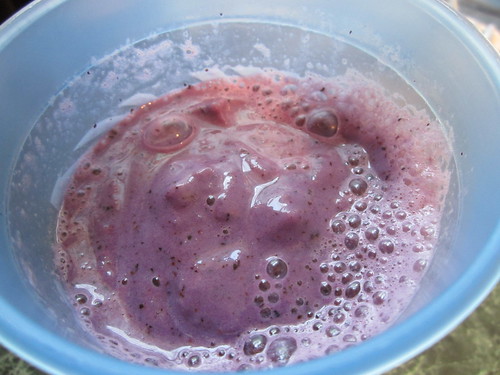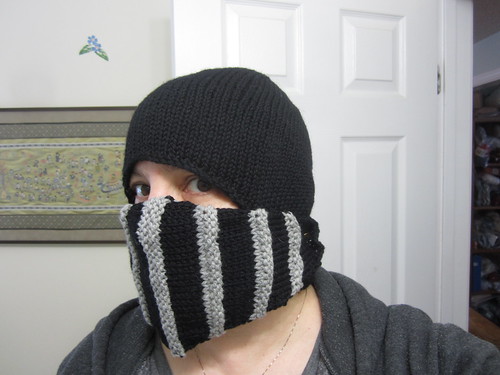Hi – Lisa here, aka lasdcm for all you Ravelry people! I am fortunate to work in the Conservation Department at the Philadelphia Museum of Art which is a contributing institution to the Integrated Pest Management Working Group created to develop resources on Integrated Pest Management for museums, and other collection holding institutions. I get tons of questions about m*ths, and I see a lot of mis-information about dealing with and repelling moths, carpet beetles, so Susie asked if I would post some good pest information or, rather, good information on bad pests!

So, you open your closet and out flies a moth, or six, what do you do?
The industry standard, a system known as Integrated Pest Management, is actually a great way to deal with bugs in your home as it does not rely on pesticides but combines, preventative and chemical measures along with close monitoring to control pests.
The MOST EFFECTIVE way to control insect infestation is good housekeeping - good housekeeping will eliminate sources of food and shelter for many pests. Consider the dust bunny: a 24/7 bed and breakfast with an all you can eat buffet! Vacuum under furniture, put all woolens away CLEAN - “Dry cleaning or thoroughly laundering items in hot water (temperature above 120°F for 20 to 30 minutes) kills all stages of insects. This is the most common and effective method for controlling clothes moths in clothing, blankets, and other washable articles.” (from UCIPM on-line) Keep yarn and sweaters in sealed plastic bags or tubs with a good tight seal. Not all plastic tubs have good seals, check the seal before purchasing.
Chemicals and pesticides should be used sparingly if at all - these chemicals are toxic, smelly, and over time bugs develop resistance. “Moth balls, flakes, or crystals containing naphthalene or paradichlorobenzene are … available for protecting clothes in storage. These materials are toxic and must be kept away from children and pets. They also leave an unpleasant odor on clothes and other cloth objects. If placed in contact with plastic buttons, hangers, or garment bags, they may cause the plastic to soften and melt into the fabric. As these chemicals evaporate, they produce vapors that, in sufficient concentration, will slowly kill insects. The vapors build up to the required concentration only in an airtight container. If the container is not airtight, the chemicals only weakly repel adults and any larvae already on clothes continue to feed.” Again from UCIMP on-line. Lavender and other herbal sachets are said to deter insects but a hungry bug will ignore the stench, and there is little if any affect on the larvae (I have found m*th larvae happily ensconced on herbal sachets – grrrr). Cedar is an effective deterrent, however most cedar chests and closets are not well sealed, thus the vapor in the cedar oils cannot build up to a lethal level. Remember, if you have not removed the sources of food and shelter, as soon as the effects of the chemicals wear off and a moth comes in on someone’s wool coat you are right back to where you started.
Got bugs already and need to kill them? First – isolate the infestation by sealing the yarn/sweater in a plastic bag and remove it! If the item is not ruined, you can kill the moths, eggs and larvae by freezing. Use a chest freezer, not frost-free* so the internal temperature remains steadily below zero F. You need to keep the bugs in an environment below -20 to -25 C or -4 to -13 F for a full week. Don’t stuff a bunch of stuff to be frozen in a big bag – keep it in several smaller/thinner packages so the entire object cools quickly. Once the infested items have been removed, take everything else out of the closet/shelves/area and clean it. Vacuum the crap out of it – paying special attention to floor baseboards, corners and other cracks where dust accumulates then seal and throw away the vacuum bag, you don’t want those eggs back in your house!
Keep an eye on your woolens! Inspect them regularly. Not only will you catch an infestation before it eats its way through your collection of hand spun, or hand knit treasures but the act of opening the closet, letting in light, moving the balls of yarn around is disruptive – moths like a dark quiet corner to eat in. I keep sweaters in individual zip-loc bags, and yarn in big zip locs. Keep your woolens clean, sealed, and keep the area clean. Vacuum often, disturb the area often by cleaning, moving, and inspecting.
*frost free freezers periodically cycle above 32 degrees in order to melt tiny ice crystals that form on various surface from the humidity trapped in the freezer.
Useful Links:
Colorado State University Extension – excellent fact sheet on clothes moths with pictures!
Cornell University’s Insect Diagnostic Lab has an excellent list of pdf’s with information on all kinds of pests
University of California – Integrated Pest Management – household pests page
National Pesticide Information Center























































